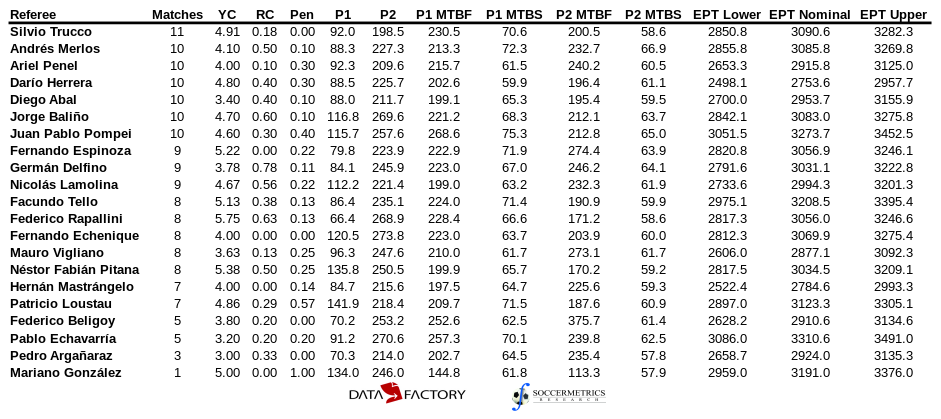Referee performance in first half of the Argentina Superliga
Categories: Referee Performance
Last season I wrote a few articles on referee performance metrics in Argentina’s Primera División. This season I present the same thing for the first half of the re-branded Superliga.
The referee-associated metrics that I have collected for each match include yellow/red cards, penalties given, time added on at end of first and second halves, mean time between fouls and stoppages, and effective playing time. All of the time calculations are estimates, but this is especially the case for effective playing time as DataFactory does not track all ball-out events. Furthermore, all times are presented in seconds. Below is the chart of averaged metrics over all of the matches officiated by the 21 Superliga referees.

Performance metrics of referees who officiated matches in 2017-18 Argentine Superliga, valid 11 December 2017. Data supplied by DataFactory LatAm.
All of the current FIFA International Referees from Argentina have officiated matches this season. They include:
- Diego Abal (2008)
- Néstor Pitana (2010)
- Patricio Loustau (2011)
- Germán Delfino (2012)
- Silvio Trucco (2013)
- Mauro Vigliano (2013)
- Fernando Rapallini (2014)
- Darío Herrera (2015)
- Jorge Baliño (2015)
- Fernando Espinoza (2016)
Diego Abal is in red because he is over 45, which means that he is subject to more rigorous review by FIFA (age limits for international referees were abolished last year).
At this point in the season a Superliga match has seen, on average, 4.4 yellow cards and 0.3 red cards shown and 0.2 penalties given. Rapallini has shown close to six yellow cards per match over his eight matches (Chacarita vs Huracán saw him show only two yellow cards, very unusual for him), while Abal has shown close to three yellow cards per match. Delfino handed out red cards at a higher rate than his peers while Pompei gave 0.4 penalties per match. Trucco, Echenique, Beligoy, and Argañaraz have yet to give a penalty in a Superliga match.
When it comes to time added on (represented by the fields “P1” and “P2”), it is interesting to observe significantly fewer time added in the first half compared to the second. Superliga referees added an average of 97.4 seconds (or 1m37.4s) to the end of the first half, and 236.0 seconds (3m56s) to the end of the second half. Here you can see more of a variance in first half stoppage time; on average, Baliño and Pompei added almost two minutes to the end of the first half, and Loustau added close to two and a half minutes. The spread for second-half stoppage time is much narrower, from Trucco at 198.5 seconds to Echineque at 273.8 seconds.
The mean time between fouls and stoppages is not entirely a function of the referee, but they do provide an insight into the fluidity of the match under the referee’s direction. There is some variation in the mean time between fouls from the first half to the second, but the mean times vary between 200 and 250 seconds (Mariano González’s match saw a mean time of 145 seconds between fouls but that was just one game). Beligoy’s matches stand out for his second halves seeing a six-minute gap between fouls called, which is two minutes wider than the gap in the first halves of his matches. I’m not sure what that means but I’ve seen a match management that loose before. As for the mean time between stoppages, there is a consistent tendency toward a greater gap between stoppages in the second half.
The average effective playing time of Superliga matches has been between 45 and 54 minutes, which is extremely low over the league competitions that I’ve studied over the years. Echavarría’s matches have the largest amount of effective playing time (55 minutes); Mastrángelo’s matches have seen the fewest (46 minutes). Of the referees who have worked more than 10 matches, most of the effective playing times fall within a narrow range, but it does appear that Herrera’s matches see less playing time (between 41-50 minutes).
So if you’ve made it this far, most of these performance metrics aren’t too far off from last season’s Primera División with the exception of effective playing time. It remains to be seen whether these trends hold up in the second half of the season.
The match data is supplied by DataFactory LatAm, which is the official data supplier for CONCACAF and CONMEBOL competitions as well as domestic competitions within the two regions.

